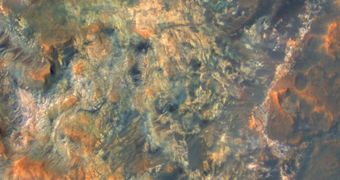One of the most important arguments supporting the idea that the Red Planet was once a wet and warm place may have just been proven false. According to a new study, the clays found at some locations on Mars may have formed from cooling lava.
Until now, scientists thought that these materials could have only appeared after liquid water flowed on the planet. As such, the fact that these clays existed hinted strongly that water must have existed, too.
However, the study indicates that similar clays can form from volcanic lava. As the molten rock cooled off and crystallized, small pockets of water droplets may have interacted with chemicals in the environment, to produce clays rich in iron and magnesium.
The clays were detected by both the NASA Mars Reconnaissance Orbiter (MRO) and the European Space Agency (ESA) Mars Express. Current estimates place their age at between 4.1 billion and 3.7 billion years, Science News reports.
Details of the new proposal – which is bound to stir up some controversy in the international astronomical community – were published in the September 9 issue of the journal Nature Geoscience.
In the past, some researchers suggested that the clays might have appeared as a result of hydrothermal activity, which may have brought water droplets to the surface to form these clays. However, there is not sufficient evidence to support this claim.
The new proposal does not require the presence of water either above or below the surface, in order to explain the old materials.
“We’re not saying all clays on Mars formed by this process. [However] if most clays formed by a magmatic process, it says maybe water wasn’t so available on early Mars,” explains Bethany Ehlmann.
The expert, a co-author of the new study, holds an appointment as a planetary geologist at the California Institute of Technology (Caltech). She adds that the amount of data we have of Mars is currently very limited, making studies of this type very difficult.
“There is a lot more work to be done before this should be accepted as the prevailing paradigm for clays on Mars,” US Geological Survey (USGS) Astrogeology Science Center director, Laszlo Kestay, goes on to say.

 14 DAY TRIAL //
14 DAY TRIAL //